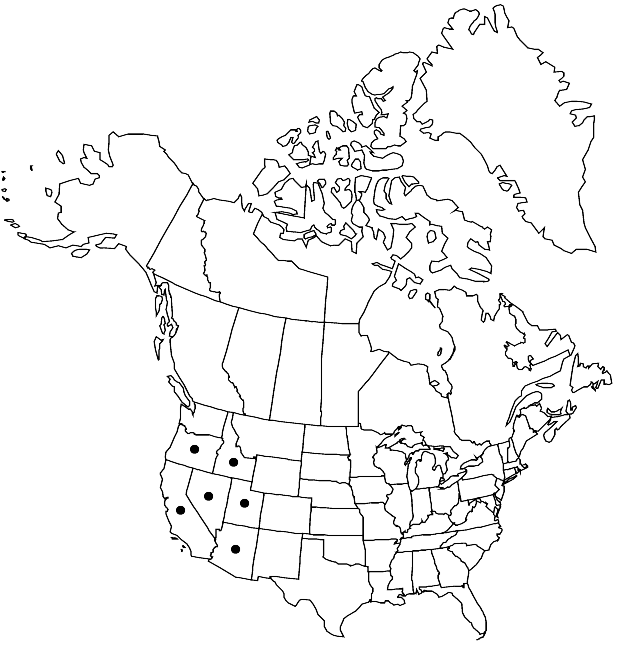Physaria kingii
Novon 12: 324. 2002.
Perennials; caudex usually simple, sometimes branched, (not thickened); usually densely pubescent, trichomes (sessile or short-stalked), 3–7-rayed, rays distinct or slightly fused at base, typically furcate near base, bifurcate or 3-partite, (not to slightly umbonate, smooth or moderately to strongly tuberculate). Stems few to several from base, prostrate to decumbent or erect, 0.5–2(–4) dm. Basal leaves: blade suborbicular to narrowly or broadly oblanceolate to broadly elliptic or rhombic, (1.2–)2–6(–8) cm, (base usually abruptly narrowed to petiole), margins entire, sinuate, or lobed. Cauline leaves: (proximal petiolate, distal sessile); blade obovate or elliptic to spatulate, 0.5–2 cm, margins entire. Racemes (usually not secund), dense, (sometimes elongated in fruit). Fruiting pedicels (erect to divaricate-ascending or recurved, erect in distal 1/3, usually sigmoid, sometimes straight or slightly curved), 4.5–10(–15) mm. Flowers: sepals lanceolate, 4–6(–7) mm; petals (yellow, cream-yellow, cream-white, or white), obovate to oblanceolate, 6–13 mm, (claw weakly differentiated from blade). Fruits (sessile or substipitate), subglobose, obovoid, or ellipsoid, compressed (sometimes slightly angustiseptate), 3–9 mm, (rigid, apex truncate, retuse, or rounded-acute); valves sparsely or densely pubescent, sometimes sparsely pubescent inside; (septum sometimes fenestrate, perforate, or obsolete); ovules 4–16 per ovary; style 1–9 mm. Seeds flattened (sometimes slightly).
Distribution

w United States, nw Mexico.
Discussion
Subspecies 7 (7 in the flora).
The Physaria kingii complex is in need of further study. It is widespread in the western United States, mostly in montane environments. This treatment recognizes a highly variable species with generally well-marked, geographically coherent subspecies. Hybridization may be involved in some of the subspecies, especially in subsp. kaibabensis, where molecular data indicate intra-individual genetic variation (pers. obs.).
Selected References
None.
Lower Taxa
Key
| 1 | Fruits slightly wider than long, apices truncate or retuse, valves pubescent inside | > 2 |
| 1 | Fruits as wide as or longer than wide, apices rounded-acute, valves glabrous inside | > 3 |
| 2 | Basal leaf blades: margins ± entire (sometimes slightly lobed or widened at base); California, Idaho, Nevada, Oregon. | Physaria kingii subsp. kingii |
| 2 | Basal leaf blades: margins sinuate or lobed, or, sometimes, lyrate; Wallowa and Elkhorn mountains, Oregon. | Physaria kingii subsp. diversifolia |
| 3 | Fruiting pedicels recurved. | Physaria kingii subsp. cobrensis |
| 3 | Fruiting pedicels not recurved (divaricate-ascending or ± erect, straight or sigmoid) | > 4 |
| 4 | Petals cream-white or white; styles 1-2 mm; Kaibab Plateau, n Arizona. | Physaria kingii subsp. kaibabensis |
| 4 | Petals yellow (occasionally cream-yellow or cream-white on Kaibab Plateau, Arizona); styles (4-)4.5-9 mm; n Arizona (including Kaibab Plateau), California, Nevada, Utah | > 5 |
| 5 | Plants erect; styles 6-9 mm; ovules 4-8 per ovary; se California. | Physaria kingii subsp. bernardina |
| 5 | Plants ascending, erect, decumbent, or prostrate; styles (4-)4.5-7 mm; ovules (6-)8-16 per ovary; n Arizona, e California, s Nevada, Utah | > 6 |
| 6 | Plants prostrate, decumbent, or erect; racemes not or somewhat secund in fruit; ovules usually 8-16 per ovary; n Arizona, e California, s Nevada, Utah. | Physaria kingii subsp. latifolia |
| 6 | Plants ascending; racemes secund in fruit; ovules (6-)8-12 per ovary; n Utah. | Physaria kingii subsp. utahensis |